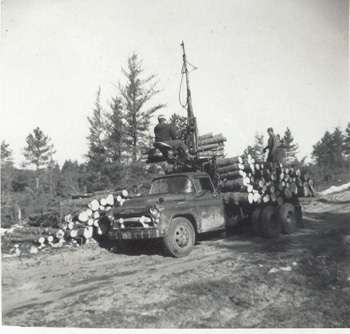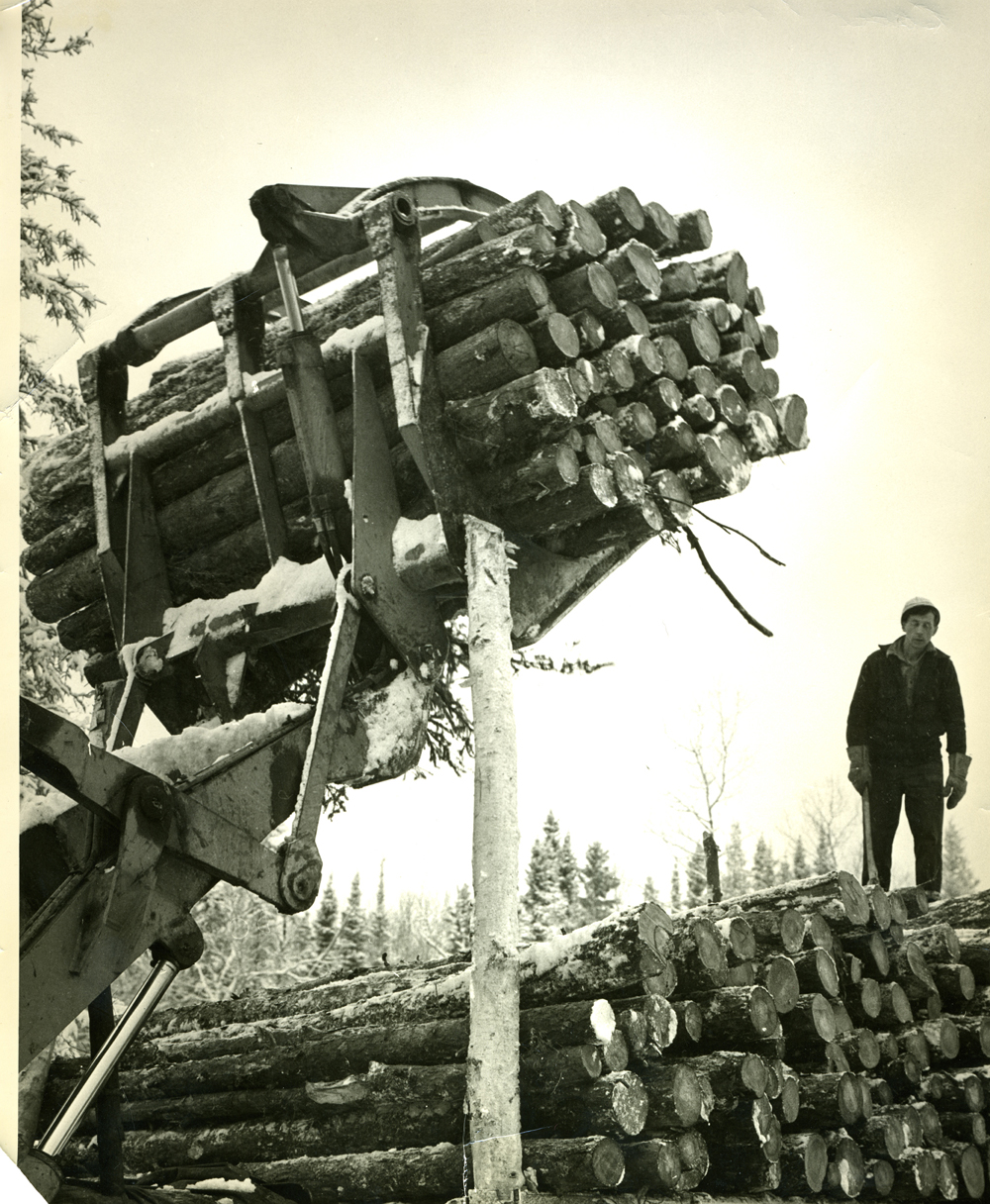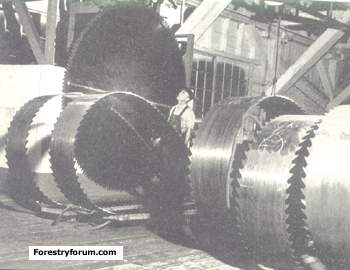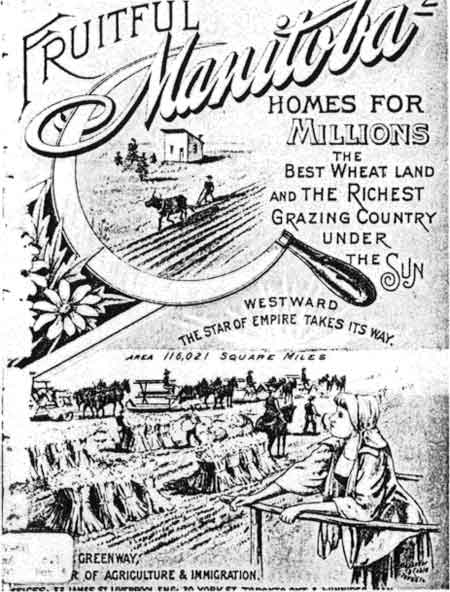This story is written for my grand children.
Nipper was a dog. He was our family dog for just over fourteen years. He came to our family as a young pup from the Winnipeg Coal Yards. I have no memory of him then as I was only three years old when he arrived so the first couple of details come from my Mom and Dad.
My father had recently arrived home from the war in Europe. His first job was delivering coal. Now-a-days when one thinks of someone driving a truck and delivering something one might think of loaders and hydraulic dump boxes. But in Winnipeg in 1946 coal came in burlap bags that weighed one hundred pounds when full. My father's job consisted of loading these one hundred pound bags of coal by hand. Then he would drive them to someone's home. Once there he would carry the bags one at a time to the coal chute. The opening of the coal chute was usually just above ground level.

Here's a picture of a coal chute. Once the door was opened a wooden trough was placed in the opening and my Dad would carry a bag to the coal chute, open the bag then empty it onto the trough. The coal would then slide down the trough and into the basement coal room. Sometimes Dad had to carry the bags all the way from the back lane to the house. At these times he would lift the bag to his shoulder and carry them to the house. At other times he could back his truck right up to the coal chute and be able to just tip the bag into the trough while he stood on the deck of the truck.

This isn't my Dad but this is how he carried the bags of coal.

One of the trucks my Dad drove looked a lot like this, but it sure wasn't shiny.
At the coal yard there was a homeless dog. All the men that worked there would bring food for her so she just moved in and became the coal yard dog; I don't ever remember Dad saying she had a name. One day as Dad and the other men arrived for work they found the coal yard dog with a litter of pups. I think Dad said there were about nine or ten. It didn't take long for the pups to grow and before you knew it, some of the men were adopting them. Dad adopted Nipper.

Nipper looked something like this. His mother was
a Collie and my Dad thought his father must have
been a German Sheperd,
Nipper almost had a short stay in our home however. My eldest sister May, who was four at the time, and I shared a bedroom. Mom and Dad agreed that at night Nipper could sleep in our room. I think it was only about a week later that the family woke up one morning to a pile of half eaten pajamas. Nipper had found all the new pajamas that Mom had hand sewn for May and I. At that time many moms sewed all the cloths for their children. That's what my Mom did and that's why she came close to having Nipper sent back to the coal yard that morning.
I'm guessing that the pleas that came from May and I as well as the assurances from Dad helped soften Mom's anger because she finally agreed that Nipper would be given one more chance, but only one more.
As I said before Nipper grew very fast and before too long he was almost full grown. That's when problems developed. You see we lived in a very small house at that time. There were two very small bedrooms, a small kitchen, a very small front room and an even smaller bathroom. And Nipper grew to be a very big dog just like his German Sheperd Dad. It wasn't so much his size that was the problem, it was his energy and his big constantly waging tail. Just by turning around in the kitchen he'd bump the table and the next thing you know Mom or Dad's coffee would be dripping over the edge and onto the floor. One wag of his tail in the front room and everything that was on the coffee table was on the floor.
Being a young dog Nipper just wanted to play and any play in the house meant that something got broken. Finally Mom and Dad decided that it just wasn't fair for such a big dog to be living in such a small place so they decided to find a home for him somewhere in the country. To do that, Dad asked the Veterinarian if he would look for a home for Nipper on a farm. He thought that on a farm Nipper would have lots of space to run and play.
One day the vet came by the house and said that he had located a new home for Nipper. So our family said our tearful good-byes and Nipper left for his new home.
But guess what happened next. One morning about five or six days after Nipper had left we woke up and he was back. Nipper was standing on the back porch with what seemed to be a big smile on his face and his big tail just wagging away. Needless to say May and I were overjoyed at this turn of events but I'm not sure Mom and Dad felt the same. He must have travelled a great distance because the pads on his feet were bleeding and he seemed exhausted. And he must have drank a gallon of water he was so thirsty. He was also so tired that within an hour he was sound asleep for the rest of the day.
My Dad thought about this for awhile and finally he phoned the vet. He asked the vet if he had taken Nipper to his new home yet. The vet said he had. Dad asked where it was and the vet said he wouldn't say exactly where it was but it was quite a way out in the country. To that Dad said thank you very much and hung up the phone. Then Dad looked at Mom, May and I and said, "Well, if Nipper wants to live here that bad the only right thing to do was to let him stay. And that we did.
One of the earliest memories I have of Nipper is being pulled in a sleigh by him as Mom and Dad walked over to my grandparents for Christmas dinner. He was able to pull the sleigh with both May and I in it.
That spring Dad got some land at Star Lake and started building a tourist camp. Our whole family would spend the summer there. This is a picture of the lake from our sandy beach.

Nipper loved the lake. We would play hid and seek with him. All the children at the camp would take Nipper down to the lake and then throw as stick a far as we could. As Nipper swam out to get the stick all the children would run and hide. Nipper would then run all over the camp finding the children one at a time. We always knew that he knew when he had found the last one. For when he found that one he would shake all the water off himself and onto that person.
In 1950 there was a big flood in Winnipeg. The house we lived in got flooded so the whole family went to the lake even though it wasn't summer. Even Grandma, Grandpa, uncles, aunts and a couple cousins came with us. When we got there the snow was still on the ground. I remember it was so deep that the bumper of Dad's truck was pushing snow from the main road all the way to our camp.

This is a picture of the flood taken from an airplane. Our home is at the bottom of this picture.
This flood marked a real change in our lives as we never did move back to Winnipeg that year. Instead we move to the lake and lived there all year long. Nipper finally had his large space.
At the lake Dad had built six cabins as well as our house.

This was our house. The people who own it now have changed it a little. There used to be a door at this end between the two sets of windows. This door was the entrance to the store Mom and Dad had. When September came along all the shelves and groceries were moved into one of the cabins. Dad then moved in some desks as this room became our school. Eight children made up the entire school. There were four from our family and four others that lived at other tourist camps on different lakes. The teacher lived with us for the whole school year. Her room was above the school.
I bet your wondering how come four children were from our family when I've only told you about May and I. Well a new baby sister (Lynne) came along shortly after we got Nipper and when I was eight Bob, a foster brother came to live with us. Bob was the same age as me.
You can't see Nipper's house as it was at the other end around the back. Nipper slept there all year long, even in the winter when the temperature got down to forty below. There was only ever one night when Nipper slept inside.
One winter some men Dad had working for him in the bush came and cut a big hole in the ice at the end of our dock. These men needed water in their camp so they took the ice from the hole back with them. They would melt a little each day for what they needed. Anyway, that night I guess Nipper forgot the hole was there, for as he ran around playing he ran right into the hole. There was a big splash and a little yelp and there was Nipper with the most worried look I ever saw on any dogs face. We were able to quickly put him out and then run him up to the house. We got an arm load of towels and the four of us rubbed him down getting him as dry as we could. We then got blankets and he laid down in front of Mom's wood cook stove.

This stove is just like Mom's
The last thing I remember seeing that night was a shivering Nipper still looking quite worried.
But by the morning he was completely dry and waiting to be let outside. All of us went skating on our rink the next day. Nipper came down to the rink as well but he steered clear of that hole. I think Dad had some harsh words for the men who cut the hole. He felt that they should not have cut it so close to our rink.

Dad hired these men to cut pulpwood for him. During Christmas holidays Bob, me and Nipper would go to the bush to work with Dad. It was our job to cut all the branches off the trees with an axe. This picture shows a man cutting a tree with a chain saw. When we first went to the bush with Dad all the men used swede saws to cut the logs.

This man is using a swede saw to cut the log.
Dad also had horses that pulled a sleigh very much like the one in the above picture only his was a little bigger and was pulled by two horses. The horses were named Dick and Jim. Dick was very gentle and was blind in one eye. Jim on the other hand was a little wild and if you weren't looking he would take a nip at your shoulder. Every once in a while Dad would let Bob and me take the load of logs out to where they were loaded onto his truck. That was the best part of any day in the bush with Dad.

One year Dad had five 1938 White trucks just like the one in this picture. They didn't pull a trailer though. There was a flat rack on them that the pulpwood was loaded onto. And no loaders! Dad loaded all the logs by hand.
During the winter one of the chores we had to do was walk out to the main road and wait for the bus that came from Winnipeg. When it drove by the driver would throw out our newspaper. I think it was the Winnipeg Tribune and it was rolled up in brown paper. We never had to pick it up though, Nipper would chase it down and scoop it up in his mouth. As soon as he had it secured between his teeth off he'd go heading for home.
During the summer Bob and I would often take one of the row boats Dad had built as we set off on a fishing adventure. Nipper would come along, sometimes in the boat and sometimes he'd follow on the shore, but he refused to stay home. We would usually leave shortly after breakfast and not be back till late afternoon. We would take turns rowing and along the way we'd stop at a meadow at the end of the bay around to the left of our camp. We'd take a lunch and some food for Nipper and stop and eat on a rock ledge that could be seen from our camp. In fact, if you look at the picture of the lake that's above you can see the spot

This is another picture from our beach. It shows the sunset and the smaller of two main islands in the lake. Dad said that before any of us could take a boat out by ourselves we had to be able to swim from the beach to the island and back again. I think that by the age of seven or eight we had all accomplished that.
As I remember Nipper was always with us kids. Winter, summer, spring and fall where ever we went Nipper was there. Bob and I would often just pick a direction and head off into the bush for the day. Nipper loved these adventures. Often he became the leader with Bob and I just tagging along.
It wasn't all fun and games though. Bob and I had our chores to do and the girls had theirs. Bob and I had to split and pile all the firewood for the cabins and our house. The worst days were wash days. This is how they went for Bob and I.
Dad had built a platform about a foot of the ground that was about twelve feet square. On this platform was a wood cook stove similar to the one Mom cooked on. There was also an old wringer washer powered by a little gas engine and a stand that held two square wash tubs. There was also a tub on the stove. Our morning started right after breakfast. Bob and I would carry two pails of water at a time from the pump down by the lake to the tub on the stove. When the water in this tub reached the right temperature Mom had us bail the water from this tub to the wringer washer. She would then start washing. We would then refill the tub on the stove and when that water was warm we would bail it into one of the tubs on the stand. We would then fill the tub on the stove again and when that was warm bail that water into the other tub on the stand. It took Bob and I about three or four trips from the pump to the stove to fill one tub. Each wash load took three tubs of water. Some days there were as many as four loads. That meant that we were carrying water till late afternoon.
But I don't think I would change very much of my time at the lake and with Nipper. He helped fill my childhood with joy and so much fun. He was the only dog I've known that a small child that he didn't know could come up to him and take his favorite bone. He would make no threats to anyone who did that. In fact he seemed almost happy to share it at times.
One of our favorite things to do is give him some pulling taffy. We only did this in the winter when Mom and Dad would take a trip into Kenora to do the months grocery shopping. While they were there they usually visited friends or went to a movie in the evening so we knew that they would not be home early. After we had supper we would make some pulling taffy. Nipper knew the taffy was being made because he would come to the back door and wait for us to open it. When the taffy was ready we would give Nipper a piece and it always got stuck to the roof of his mouth. That's because we sort of helped it stick there by giving it a push in that direction as we placed it in his mouth. We all would spend the next ten or fifteen minutes in laughter at Nipper's expense as he struggled to dislodge the sticky taffy with his tongue.
One summer Nipper even saved a little girls life. She was in shallow water but somehow fell and could not get up. Nobody noticed, at least not the people. But Nipper did. He ran into the water and grabbed hold of the strap of her bathing suit with his teeth and pulled her to shore. That's when the people noticed and rushed to pick her up. The little girl was coughing a lot but thanks to Nipper she didn't drown.
I'm sure every member of my family have their own cherished memories of Nipper. It would take a book to tell you all of mine. As I said before he lived to the ripe old age of fourteen and a half years. In the spring of 1961 Nipper died. Dad, Lynne and I took him out to a nice spot in the bush and buried him. I visited that spot in 1992. It looks a little different now. There are more trees and one in particular, a white birch, now grows directly over where he was buried. I was happy to see that as the roots of birch trees don't grow very deep. They sort of just spread out over the surface. It was as if the birch tree was protecting that spot.
Some day I may tell you a little more about Nipper, my best childhood Friend. If I forget you can always ask and I'll tell you more.
























